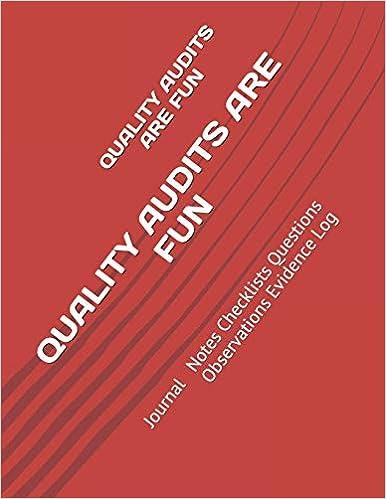Question
Identify 2 professional organizations that the incoming forensic team should consider for membership. Include rationale. Remedies available for civil and criminal justice systems. Identify and
- Identify 2 professional organizations that the incoming forensic team should consider for membership. Include rationale.
- Remedies available for civil and criminal justice systems.
- Identify and explain the approaches used by investigators to obtain documents.
- Define and give examples of demonstrative evidence.
- Explain the factors that affect the decision to prosecute an entity or individual.
- Identify and explain with examples off-book fraud, skimming, cash larceny, asset misappropriation, and inventory shrinkage.
- Specify preventions that could be put in place for each type of fraud.
Professional Organizations for Membership:
Association of Certified Fraud Examiners (ACFE): Offers resources, training, and a network of professionals focused on fraud prevention and detection.
American Institute of Certified Public Accountants (AICPA): Provides guidance on forensic accounting and auditing, enhancing skills for investigative work.
Remedies in Civil and Criminal Justice Systems:
Civil System: Remedies include restitution, compensatory damages, and injunctive relief, which aim to restore the victim to the pre-fraud position.
Criminal System: Remedies include fines, probation, and incarceration, with the goal of punishing offenders and deterring future fraud.
Approaches for Obtaining Documents:
Document Requests: Requesting relevant documents from the entity or individual under investigation.
Subpoenas: Legally compelling third parties to provide documents.
Search Warrants: Obtaining court orders to search premises and seize documents.
Demonstrative Evidence:
Demonstrative evidence helps illustrate and clarify complex concepts in court. Examples include charts, graphs, videos, and simulations.
Factors Affecting Prosecution Decision:
Sufficiency of Evidence: The strength of the evidence collected.
Public Interest: The potential impact on the community.
Resource Allocation: The cost and effort required for prosecution
Types of Fraud and Prevention:
Off-Book Fraud: Concealing transactions from records. Prevention: Implement strong internal controls and regular audits.
Skimming: Diverting cash before it's recorded. Prevention: Segregate duties and monitor cash handling.
Cash Larceny: Stealing cash after it's recorded. Prevention: Enhance security measures and employee oversight.
Asset Misappropriation: Misusing company assets. Prevention: Strict access controls and inventory management.
Inventory Shrinkage: Loss of inventory due to theft or errors. Prevention: Implement inventory tracking systems and conduct regular reconciliations.
Question:
I need an introduction on this
Step by Step Solution
There are 3 Steps involved in it
Step: 1

Get Instant Access to Expert-Tailored Solutions
See step-by-step solutions with expert insights and AI powered tools for academic success
Step: 2

Step: 3

Ace Your Homework with AI
Get the answers you need in no time with our AI-driven, step-by-step assistance
Get Started


